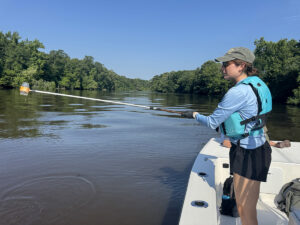News
Is it pollution? Or is it pollen?
Education, Environmental, Neuse River Watershed, Sound Rivers, Tar-Pamlico Watershed
Posted on March 21st, 2024
It happens every year in eastern North Carolina: the weather warms, plants start to bloom, and fine, yellow pine pollen coats every surface imaginable — including our waterways.
If you see swaths of yellow muck on the river, on the shorelines, on the creeks and more, there’s no need to be alarmed. It’s pine pollen.
According to the Assateague Island National Seashore Facebook page, pine pollen is unique. In “pollen speak,” it’s considered large (60-100 micrometers in size compared to other pollen grains, which are mostly approximately 10 micrometers) and as such, should be too heavy to travel through the air.
This is where it gets interesting: to compensate for its large size, pine pollen has two air capsules attached to either side of the pollen grain itself; if you were to look at pine pollen under a microscope, it would look like a Mickey Mouse head with the ears being the capsules. The air capsules reduce the weight of the pollen grain and make it easier to travel though the air. When the pine pollen settles out of the air and onto the water, the same air capsules make the pollen grains buoyant, so they float on the water. As the wind blows toward shore, the grains are pushed into one another and creates what appears to be a latex paint like mass along the shoreline.
Right now, that yucky stuff in the water isn’t pollution. It’s just pollen.
Related News

Neuse fish kill expected to extend beyond holiday weekend
July 3rd 2025

Swim Guide fails prompt Maple Cypress investigation
July 3rd 2025

Riverkeeper, town partners root out source of Smithfield sediment pollution
July 3rd 2025

Trash trap No. 12 approved for Smithfield
July 3rd 2025

Sunset River Paddle fundraiser boosts Water Quality Fund
July 3rd 2025

Riverkeepers host quarterly Water Watch meeting
July 3rd 2025

Public hearing will determine the fate of many NC wetlands
June 26th 2025

Clayton gets first official trash-trap cleanout
June 25th 2025

